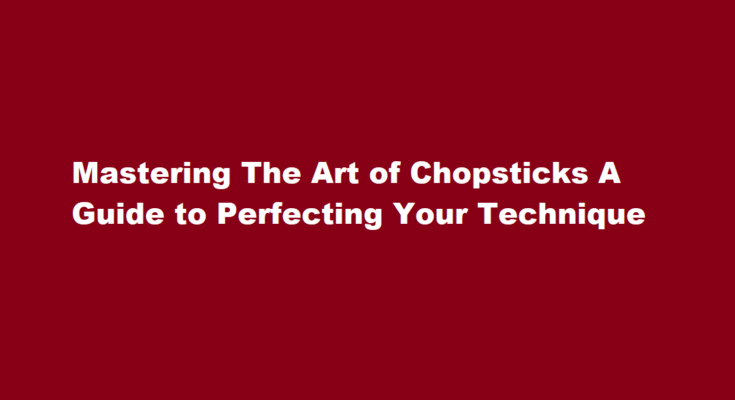Chopsticks are not just utensils; they are an integral part of Asian cuisine and culture. Originating in China over 5,000 years ago, these slender sticks have become a symbol of precision and dexterity. While using chopsticks may seem intimidating to those unfamiliar with them, with a bit of practice and patience, anyone can become adept at this ancient art. In this article, we will explore the proper technique for using chopsticks and offer helpful tips to enhance your skills.
Choosing the Right Chopsticks
Before diving into the technique, it is essential to select the appropriate chopsticks. Traditional chopsticks are typically made of wood or bamboo, while modern variations can be found in materials like stainless steel or plastic. Beginners often find it easier to start with chopsticks that have textured tips or rubber grips, as they provide better control and grip on food.
Holding the Chopsticks
To begin, hold one chopstick as you would hold a pencil, positioning it in the base of your thumb and resting it on your ring finger. This chopstick remains stationary throughout the process. Next, position the other chopstick slightly above the stationary one, grasping it between your thumb and index finger. This chopstick will serve as the active one, allowing you to manipulate food.
The Pincer Grip
Mastering the pincer grip is the key to successfully using chopsticks. Imagine the chopsticks as an extension of your fingers. Use your thumb and index finger to control the top chopstick, while your middle finger acts as a stabilizer for the bottom chopstick. Practice opening and closing the chopsticks repeatedly to get a feel for the movement and to develop muscle memory.
Basic Techniques
- Picking Up Food Begin by using the pincer grip to pick up larger pieces of food, such as dumplings or sushi rolls. Position the chopsticks around the food item, gently applying pressure to secure it. Avoid squeezing too tightly, as this can cause the food to slip away.
- The Scoop Technique For smaller or loose food items like rice or vegetables, employ the scoop technique. Use the top chopstick as a lever, resting it on your ring finger and securing the food against the stationary chopstick. Scoop up the food by raising the active chopstick slightly.
- Rotating Technique When dealing with cylindrical food items like noodles or shrimp, employ the rotating technique. Position the chopsticks parallel to the food item, then rotate your wrist and twist the chopsticks in opposite directions to entwine the food.
Proper Etiquette
Using chopsticks also involves observing proper etiquette, particularly in Asian cultures. Here are a few guidelines to follow
- Do not use chopsticks to spear food. It is considered impolite.
- Avoid crossing your chopsticks or sticking them upright in your food. These actions symbolize death and are considered disrespectful.
- Never pass food directly from your chopsticks to someone else’s; it resembles a funeral ritual. Instead, place the food on a shared plate or use serving utensils.
Practice Makes Perfect
Becoming proficient with chopsticks requires practice. Start with easy-to-handle foods and gradually progress to more challenging items. Consider taking a cooking class or watching online tutorials to improve your skills. Remember, the more you practice, the more comfortable and proficient you will become.
Embrace the Experience
Using chopsticks is not just about eating; it is an opportunity to immerse yourself in Asian culture and cuisine. Embrace the experience with an open mind and a willingness to learn. Don’t be afraid to make mistakes—learning from them is an essential part of the process.
FREQUENTLY ASKED QUESTIONS
Are chopsticks easier to use?
Chopsticks are comfortable and easy to use, but mastering them is an art, much like the humble knife and fork. Beginner chopsticks can have a helper hinge to hold the two sticks together, ideal for younger or less dextrous diners.
What age can you learn chopsticks?
Children in Japan usually start learning to use chopsticks by the age of 4 or 5. There are various training chopsticks available for beginner users. Before you start—Watch the chapter “Shiori” in the video: “Many Homes in Kyoto, Japan.” Shiori and her mom prepare a hamburger and eat it with rice.
In conclusion, using chopsticks is a skill that can be acquired by anyone willing to invest time and effort. By selecting the right chopsticks, mastering the pincer grip, and practicing various techniques, you can become proficient in the art of chopsticks. Remember to observe proper etiquette and approach the learning process with patience and enthusiasm. So go ahead, grab a pair of chopsticks, and embark on a culinary adventure that connects you to a rich cultural heritage. Happy chopstick wielding!
Read Also : Mastering The Art of Bidet Usage A Step-by-Step Guide



